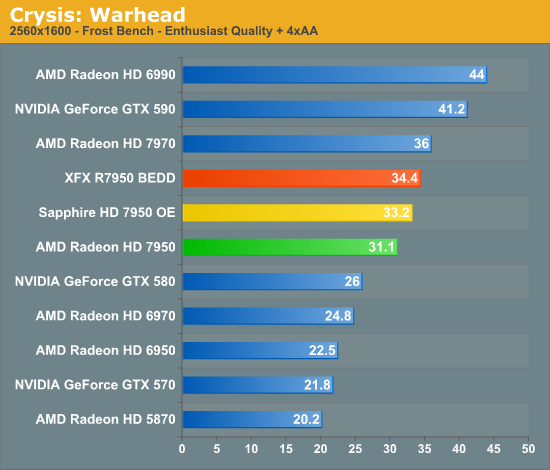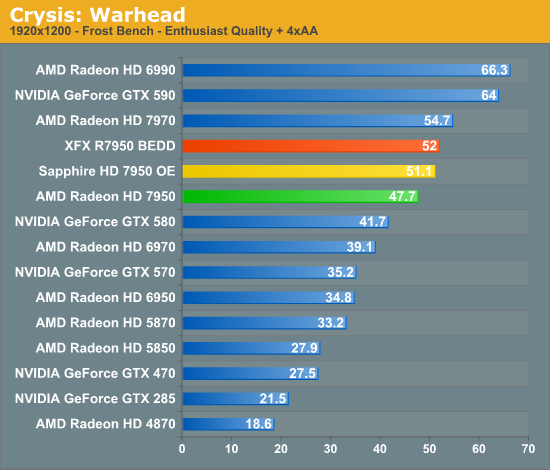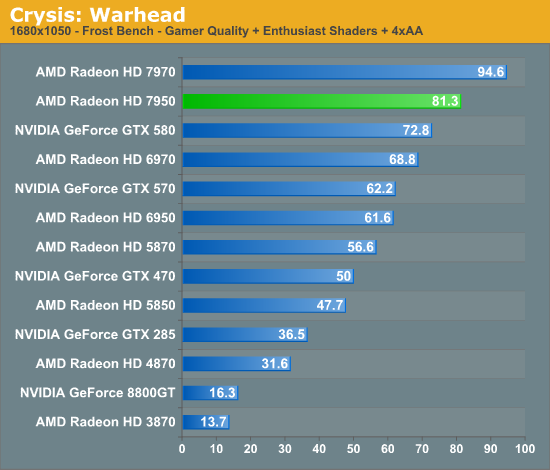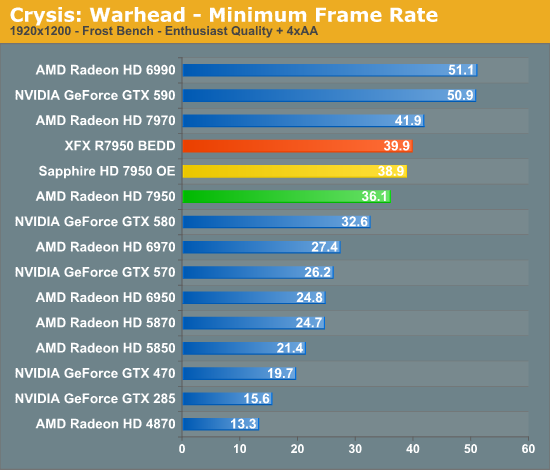AMD Radeon HD 7950 Review Feat. Sapphire & XFX: Sewing Up The High-End Market
by Ryan Smith on January 31, 2012 9:02 AM ESTCrysis: Warhead
Kicking things off as always is Crysis: Warhead. It’s no longer the toughest game in our benchmark suite, but it’s still a technically complex game that has proven to be a very consistent benchmark. Thus even 4 years since the release of the original Crysis, “but can it run Crysis?” is still an important question, and the answer continues to be “no.” While we’re closer than ever, full Enthusiast settings at a 60fps is still beyond the grasp of a single-GPU card.



AMD’s first round of driver optimizations have given the 7900 a very solid footing in Crysis, putting the 7950 off to a great start. The 7950 is 19% ahead of the GTX 580 at 2560 and 14% ahead at 1920, putting the card in a comfortable position that for single-GPU cards is second only to the 7970. In spite of Crysis being shader-bound most of the time the 7950 is generally within 15% of the 7970, so it’s doing better than the theoretical performance gap between the two cards would predict. Meanwhile compared to AMD’s last generation offerings it’s not much of a contest: the 7950 is 20-25% ahead.
As for our factory overclocked Sapphire and XFX cards, they further close the gap between the 7950 and 7970. The 12.5% core overclock on these cards puts them between 7% and 10% faster than the stock clocked 7950, with the XFX card edging out the Sapphire due to its memory overclock. These cards do so well here than the reference 7970’s lead is reduced to just 5%.



The minimum framerates in Crysis are also looking good on the 7950, with the 7950 turning in a 10-22% better minimum framerate than the GTX 580 depending on whether we’re talking about 1920 or 2560. As like we saw with the 7970, the biggest lead is at the highest resolutions, which has typically been the case for AMD cards for some time now. The overclocked partner cards add to this, tacking on an extra 5-10% in performance.










259 Comments
View All Comments
Ryan Smith - Tuesday, January 31, 2012 - link
Correct. That's BIOS 015.013.000.010.000705Ryan Smith - Tuesday, January 31, 2012 - link
I should add that this is also the build number of the BIOS on Sapphire's card.AnandThenMan - Tuesday, January 31, 2012 - link
Thanks for the info, appreciated.Sttm - Tuesday, January 31, 2012 - link
There is 0 chance these retarded prices will remain past Nvidia's next gen launch. At that point the 7950 will drop below $300 to be competitive. So if you pay $450 now, you are a chump.mdlam - Tuesday, January 31, 2012 - link
NO....maybe its because you just want the best card. just like all the other "chumps" were paying 500 for a gtx580 or still are, which is a completely disproportionately unfavorable price/performance ratio compared to the 560ti/6950 unlocked.rronald1 - Tuesday, January 31, 2012 - link
I was hoping for $300-350 price tag for 7950.Right now it´s much better to get 2x second hand 6970 running in crossfire, you will get better performances than even 7970 or even 6990.
But we all know the price will drops like stones once Kepler hits the market.
mdlam - Tuesday, January 31, 2012 - link
Only if Kepler isn't a total fail like FermiEugene86 - Tuesday, January 31, 2012 - link
Except Fermi wasn't a fail...artk2219 - Wednesday, February 1, 2012 - link
The original Fermi could most definitely count as a fail, hot loud, power hungry, big, expensive for only 20% more power than a 5870, and LATE, it was fun to watch :). It wasn't until the 460 and the release of the 500 series that Nvidia got that mess worked out.Veroxious - Tuesday, January 31, 2012 - link
While the performance is impressive, the pricing is just ridiculous and leaves a bittter taste in the mouth. One could get similar performance from 2 x 6850 /2 x gtx460's for $320-360.For my next upgrade I was looking for slightly more horsepower than a single gtx580 combined with Ivy bridge. Ofcourse 1st prize for me is a single powerful gpu as opposed to sli/crossfire but at $450 for a reference card it's just pointless. We'll see what happens with Kepler but it seems AMD is setting a recurring trend of increased base cost for every architectural generation which means the costs just keep escalating. What was once a small caliber hole in my pocket seems to have become a 12-gauge crater. Arrrghhhh.........